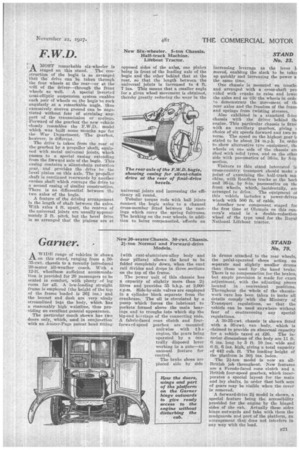F.W.D.
Page 145

If you've noticed an error in this article please click here to report it so we can fix it.
. AMOST remarkable six-wheeler is staged on this stand. The construction of the bogie is so arranged that the drive can be taken through the four wheels at the rear—or at the wilt of the driver—through the front
wheels as well. A special inverted Semi-elliptic suspension system enables each pair of wheels on the bogie to rock angularly at a remarkable angle, thus excessively uneven ground can be negotiated without fear of straining, anypart of the transmission or springs. Forward of the gearbox the new vehiele 1' closely resembles the F.W.Ds model which was built some Months ago fer the War Department. The gearbox, however, is different.
The drive is taken from the rear ot the gearbox by a propeller 'shaft, equiptied with metal universal joints, which passes to a special casing extending from the forward axle of the bogie. This easing contains a silent-chain reduction gear, and provides the drive to Inc bevel pinion on this axle. The propeller shaft is continued rearwards by another cardan shaft which conveys the drive to a second easing of similar construction. There. is no differential between the two axles of the bogie.
A feature of the driving arrangement Is the length of shaft between the axles. With axles 4 ft. apart, the centres of the universal joints are usually approximately 2 ft. pitch, but the bevel drive is so arranged that the pinions are at
opposed sides of the axles; one pinion being in front of the leading axle of the bogie and the other behind that at the rear, so that the length between the universal joints is increased to 4 ft. 7 ins. This means that a smaller angle for a given wheel movement is obtained, thereby greatly reducing the wear in the
universal joints and increasing the efficiency all round.
Tubular torque rods with ball joints connect the bogie axles to a channel cross-member fitted between the castings which carry the spring fulcrums. The braking on the rear wheels, in addition to being compensated, affords an increasing leverage as the lever ii moved, enabling the slack to be take, up quickly and increasing the power a the same time.
One chassis is mounted ' on trestle; and arranged with a cross-shaft pro vided with cranks to raise and towel the axles and so tilt-the wheels in orde: to demonstrate the movement of tb. rear axles and the freedom of the frann and springs from twisting stresses.
Also exhibited is a standard 5-tor chassis with the driver behind tilt engine. This particular chassis is fittee with an auxiliary gearbox, giving u choice of six speeds forward and two re verse. The speed on the highest gear b. stated to be about 24 m.p.h. In ordei to shovr: alternative tyre equipment, tip wheels on one side of the chassis arc shod with solid tyres, and on the othei side with pneumatics of 36-in. by 8-in
section.
Visitors to this stand interested is cross-country transport should make a point of examining the half-track maebine, with Roadless tracks at the back and 36-in. by 8-in, pneumatics on thc front wheels, which, incidentally, arc arranged to drive. The equipment oi this vehicle includes a power-drives winch with 500 ft. of cable.
Another new component staged for the first time at Olympia on this concern's stand is a double-reduction wheel of the type used for the Royal National Lifeboat tractor.


















































































































































































































































































































